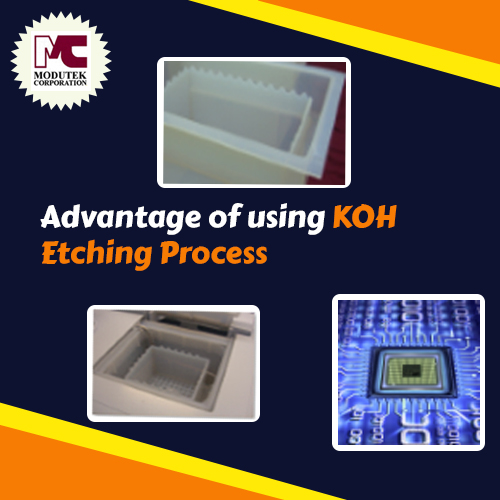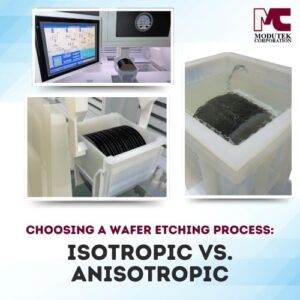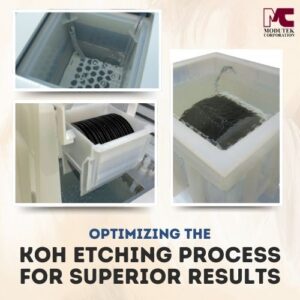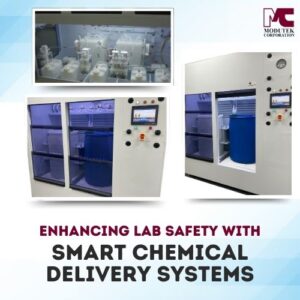 The KOH etching process uses a potassium hydroxide solution to etch silicon wafers and produce microscopic structures in the silicon. In subsequent semiconductor fabrication steps, the micro structures are used in the manufacture of integrated circuits, processors and other electronic devices.
The KOH etching process uses a potassium hydroxide solution to etch silicon wafers and produce microscopic structures in the silicon. In subsequent semiconductor fabrication steps, the micro structures are used in the manufacture of integrated circuits, processors and other electronic devices.
Compared to other etching processes KOH etching is comparatively safe, etches silicon rapidly and can be tightly controlled. These characteristics are especially important for batch processing when a process step has to be reproduced precisely many times. While other chemical processes are required for specific semiconductor cleaning and etching steps, industrial plants and research facilities prefer the KOH process for general silicon etching.
How the KOH Etching Process Works
The KOH solution is prepared by adding KOH to water in an etching tank made of material impervious to aggressive chemicals. Silicon wafers are masked with silicon nitride or silicon dioxide, substances that the KOH solution does not etch. When the wafers are immersed in the KOH solution, silicon is removed from the areas that are not masked by the chemical action of the KOH etching solution.
The etch rate can be controlled by changing the concentration of the solution and by changing the temperature. The concentration is fixed once the process is established and is usually around a 30% solution by weight, but may be as low as 10% and as high as 50%. Typically the solution temperature is about 60 to 80 degrees centigrade and the etch rate increase is very sensitive to an increase in temperature.
Other factors influencing the etch rate are the crystal lattice planes of the silicon and the presence of boron doping. Different crystal lattice orientations are etched at different rates so that the crystal lattice planes influence the design of the masks and their placement. Boron doping can be used to stop the etching in a specific direction. Taken together, all the ways the etch rate can be controlled allow the creation of complex shapes in the silicon.
Controlling KOH Etching
Obtaining the desired etching results from the KOH process can be divided into two groups of control measures. The concentration, doping and lattice orientation are determined initially before the process starts and establishes itself. At that point, temperature control can still change the etching rate. The initial control measures can be put in place with the required precision, concentration and other characteristics but the temperature of the etching solution must be controlled accurately on a continuing basis.
Because the KOH etching process is very temperature sensitive, maintaining the temperature at the exact set point is important. The temperature controller must be accurate during the process and also from one batch to the next. Tight control during the etching process ensures that the etch rate remains constant while precisely keeping the same temperature for a given set point from one batch to the next ensures accurate reproducibility of process conditions and identical output across different batches.
Modutek’s Teflon Silicon Etch Tanks
Using Modutek’s Teflon tanks allows operators to fully benefit from the advantages of KOH etching. The tanks are designed with KOH etching in mind and feature a wide temperature range, tight temperature control and rapid heating. Custom sizes are available and custom installations can be designed to fit any new or existing wet bench application.
Heating in Modutek’s Teflon tanks is either in line or through an immersion heater in the overflow weir. Temperatures can be controlled to plus/minus 0.5 degrees centigrade and the temperature range is 30 to 100 degrees centigrade. The heating rate is 2 to 3 degrees per minute, depending on the size of the system, and heating is even throughout the bath. Since temperature control is a key requirement for successful KOH etching, these system characteristics allow for excellent reproducibility between batches and for the precise control needed for high quality output.
Apart from excellent temperature controls, Modutek’s Teflon tanks feature all TFA Teflon with advanced manufacturing techniques designed to minimize contamination. Options such as an auto lid feature or a condensing refluxor are available if needed. Modutek Teflon tanks are an ideal solution for KOH etching applications and the company can help select the model and options that best satisfy specific customer needs. Contact Modutek for a free consultation on selecting the right equipment for specific process requirements.
Reviewed and Approved by Douglas Wagner
President & CEO, Modutek Corporation




